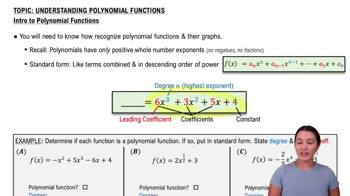State whether the functions represented by graphs A , B , C and in the figure are even, odd, or neither. <IMAGE>
Table of contents
- 0. Functions7h 52m
- Introduction to Functions16m
- Piecewise Functions10m
- Properties of Functions9m
- Common Functions1h 8m
- Transformations5m
- Combining Functions27m
- Exponent rules32m
- Exponential Functions28m
- Logarithmic Functions24m
- Properties of Logarithms34m
- Exponential & Logarithmic Equations35m
- Introduction to Trigonometric Functions38m
- Graphs of Trigonometric Functions44m
- Trigonometric Identities47m
- Inverse Trigonometric Functions48m
- 1. Limits and Continuity2h 2m
- 2. Intro to Derivatives1h 33m
- 3. Techniques of Differentiation3h 18m
- 4. Applications of Derivatives2h 38m
- 5. Graphical Applications of Derivatives6h 2m
- 6. Derivatives of Inverse, Exponential, & Logarithmic Functions2h 37m
- 7. Antiderivatives & Indefinite Integrals1h 26m
- 8. Definite Integrals4h 44m
- 9. Graphical Applications of Integrals2h 27m
- 10. Physics Applications of Integrals 2h 22m
0. Functions
Properties of Functions
Problem 1.7
Textbook Question
In Exercises 5–8, determine whether the graph of the function is symmetric about the 𝔂-axis, the origin, or neither.
𝔂 = x² - 2x - 1
 Verified step by step guidance
Verified step by step guidance1
To determine symmetry about the y-axis, check if the function is even. A function f(x) is even if f(x) = f(-x) for all x in the domain. Substitute -x into the function: y = (-x)² - 2(-x) - 1.
Simplify the expression: y = x² + 2x - 1. Compare this with the original function y = x² - 2x - 1. Since they are not equal, the function is not symmetric about the y-axis.
To determine symmetry about the origin, check if the function is odd. A function f(x) is odd if -f(x) = f(-x) for all x in the domain. Substitute -x into the function: y = (-x)² - 2(-x) - 1 and simplify to get y = x² + 2x - 1.
Now, check if -f(x) = f(-x). Calculate -f(x): -f(x) = -(x² - 2x - 1) = -x² + 2x + 1. Compare this with f(-x) = x² + 2x - 1. Since they are not equal, the function is not symmetric about the origin.
Since the function is neither even nor odd, it is neither symmetric about the y-axis nor the origin.
 Verified video answer for a similar problem:
Verified video answer for a similar problem:This video solution was recommended by our tutors as helpful for the problem above
Video duration:
3mPlay a video:
Was this helpful?
Key Concepts
Here are the essential concepts you must grasp in order to answer the question correctly.
Symmetry about the y-axis
A function is symmetric about the y-axis if replacing x with -x in the function yields the same function. Mathematically, this means that f(-x) = f(x). For polynomial functions, this often indicates that all the exponents of x are even.
Recommended video:

Properties of Functions
Symmetry about the origin
A function is symmetric about the origin if replacing x with -x and y with -y results in the same function. This is expressed as f(-x) = -f(x). Functions that exhibit this symmetry typically contain only odd powers of x.
Recommended video:

Properties of Functions
Analyzing polynomial functions
Polynomial functions can be analyzed for symmetry by examining their terms. The degree and the coefficients of the terms determine the function's behavior under transformations. For the given function, identifying the terms will help in determining its symmetry properties.
Recommended video:

Introduction to Polynomial Functions

 6:21m
6:21mWatch next
Master Properties of Functions with a bite sized video explanation from Nick
Start learningRelated Videos
Related Practice
Textbook Question
25
views
